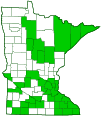pitted mason wasp
(Euodynerus foraminatus)
Conservation • Description • Habitat • Ecology • Distribution • Taxonomy
|
|
||||||||||||||
Description |
Pitted mason wasp is a common, small, solitary wasp. It occurs across the United States and southern Canada, where it is common east of the Great Plains, uncommon in the west. It is the most common Euodynerus species in the east except at northern localities, and the most common Euodynerus species collected in bee blocks by the Minnesota Bee Atlas. Adults are black with yellow markings. The front part of the body (mesosoma) is connected to the rear part (metasoma) by a narrow waist that is not elongated petiole-like. Wasp size is often given in terms of the length of the forewing. The female forewing length is ¼″ to 7⁄16″ (7.0 to 10.5 mm), the male forewing length is ¼″ to ⅜″ (6 to 9 mm). On the female the head is black. There are two large compound eyes, one on each side of the head, and three small simple eyes (ocelli) in a triangle at the top of the head between the compound eyes. The inner margin of each compound eye is deeply notched. The antennae are thread-like and have 12 segments, including a long first segment (scape) at the base, a short second segment (pedicel), and a whip-like section (flagellum) with 10 segments (flagellomeres). The scape is black above, bright yellow below. The first flagellomere is at least 1.3 times as long as the second. The last flagellomere is not hooked at the tip. The plate on the face (clypeus) is strongly convex on the lower margin. It is black with a yellow crescent-shaped band on the upper margin that is sometimes broken into two narrowly separated spots. The cheeks (genae) narrow toward the bottom, tapering nearly to a point. The jaws (mandibles) are long and knife-like. The upperside of each mandible is yellow near the base. There is a yellow spot between the antennae bases and a small yellow spot behind each compound eye. The thorax is black and has three segments, the prothorax, mesothorax, and metathorax. However, the first segment of the abdomen (propodeum) is fused to the thorax, giving the thorax the appearance of having four segments. The upper plate on the prothorax (pronotum) is short and collar-like. It has a narrow transverse ridge (carina) on the front margin. It extends rearward on the sides to the plate at the base of each wing (tegula). It appears horseshoe-shaped when viewed from above, triangular when viewed from the side. It is mostly black except for a yellow band on the front margin of the upper surface. The band narrows toward the middle and is narrowly interrupted in the middle. The rear face of the pronotum does not have a pair of pits in the middle. On the mesothorax, the large front plate (scutum) is black with no yellow markings. The scutum has two small projections at the rear corners called parategula, a feature common to all potter or mason wasps (family Eumeninae). The parategulae are yellow. The smaller rear plate (scutellum) has a pair of rectangular, narrowly separated, yellow spots. The upper surface of the metathorax is entirely black, with no yellow markings. The propodeum has a very prominent transverse ridge (submarginal carina). The valve on the propodeum (propodeal valvula) is fused to the submarginal carina. The tegulae are yellow, and there is a small yellow spot on the side of the thorax below each wing base. The metasoma has six segments (tergites). The first tergite is wider than long and no more than 1.4 times as long as the second tergite. It does not have a transverse carina. It is black with a yellow band at the rear. The band is narrowly notched in the middle, but it is complete, not interrupted. The second tergite is wider than the first almost as long as the remaining tergites combined. It has a yellow band at the rear. It does not have a small yellow spot on each side. The third through fifth tergites have a complete narrow yellow band at the rear. The sixth tergite is entirely black. Tergites 2 through 4 are coarsely, deeply, and densely pitted (punctate). The rear half of the metanotum is shiny, despite the punctation. The wings are pale smoky brown with purplish reflections. The forewing has three submarginal cells. The media vein (M) is nearly straight or very slightly angled at the base of the second submarginal cell. The legs are black and yellow. On each leg the third segment (femur) is mostly black, yellow just at the tip above, and yellow on the outer half below. The fourth segment (tibia) is entirely yellow. The tibiae on the middle leg has a single spur at the tip. The last part of each leg (tarsus), corresponding to the foot, has five segments. They are yellow except for the last segment, which is black. There is a pair of claws at the tip of each tarsus. The claws are split (cleft) at the end. The male is similar but slightly smaller. The antennae have 13 segments. The flagellum is hooked at the tip, and the last flagellomere is stout. The clypeus is entirely yellow. The parategulae are almost always yellow. The rear part of the body has seven visible segments. The sixth tergite also has an uninterrupted yellow band at the rear margin. On the front legs, the femur has erect hairs above and below. |
Size |
Female forewing length: ¼″ to 7⁄16″ (7.0 to 10.5 mm) Male forewing length: ¼″ to ⅜″ (6 to 9 mm) |
Similar Species |
Habitat |
|
Ecology |
Season |
One or two generations per year: early summer to early fall |
Behavior |
The wings are folded longitudinally over the body when at rest. |
Life Cycle |
Nests are made in cavities, including hollow twigs, corrugated cardboard, abandoned nests of paper wasps, and in borings in wood, such as in bee blocks. They are provisioned with paralyzed moth caterpillars. The cells are partitioned and closed with mud or with agglutinated sand. |
Larva Food |
|
Adult Food |
|
Distribution |
||
|
Sources |
|
| 5/1/2024 | ||
Occurrence |
||
Common |
||
Taxonomy |
|
Order |
Hymenoptera (Ants, Bees, Wasps, and Sawflies) |
Suborder |
Apocrita (Narrow-waisted Wasps, Ants, and Bees) |
No Rank |
Aculeata (ants, bees, and stinging wasps) |
Superfamily |
Vespoidea |
Family |
Vespidae (hornets, paper wasps, potter wasps, and allies) |
Subfamily |
|
Genus |
|
no rank |
Euodynerus foraminatus complex |
Subordinate Taxa |
|
|
|
Synonyms |
|
|
|
Common Names |
|
pitted mason wasp |
|
Glossary
Carina
An elevated keel or ridge.
Clypeus
On insects, a hardened plate on the face above the upper lip (labrum).
Flagellomere
A segment of the whip-like third section of an insect antenna (flagellum).
Gena
In insects: The area between the compound eye and the mandible; the cheek. In birds: The area between the the angle of the jaw and the bill; the feathered side (outside) of the under mandible. Plural: genae.
Mesosoma
In Hymenoptera: the front part of the body, consisting of all three segments of the thorax and the first segment of the abdomen, to which the wings are attached.
Metasoma
In Hymenoptera: the armored rear part of the body, consisting of the second segment of the abdomen and all segments posterior to it.
Ocellus
Simple eye; an eye with a single lens. Plural: ocelli.
Pedicel
On plants: the stalk of a single flower in a cluster of flowers. On insects: the second segment of the antennae. On Hymenoptera and Araneae: the narrow stalk connecting the thorax to the abdomen: the preferred term is petiole.
Propodeum
In Hymenoptera: the last segment of the thorax, anatomically the first segment of the abdomen.
Punctate
Dotted with pits (punctures), translucent sunken glands, or colored spots of pigment.
Scape
In plants: An erect, leafless stalk growing from the rootstock and supporting a flower or a flower cluster. In insects: The basal segment of the antenna.
Tarsus
On insects, the last two to five subdivisions of the leg, attached to the tibia; the foot. On spiders, the last segment of the leg. Plural: tarsi.
Tegula
A small, hardened, plate, scale, or flap-like structure that overlaps the base of the forewing of insects in the orders Lepidoptera, Hymenoptera, Diptera, and Homoptera. Plural: tegulae.
Tergite
The upper (dorsal), hardened plate on a segment of the thorax or abdomen of an arthropod or myriapod.
Tibia
The fourth segment of an insect leg, after the femur and before the tarsus (foot). The fifth segment of a spider leg or palp. Plural: tibiae.
Visitor Photos |
||
Share your photo of this insect. |
||
This button not working for you? |
||
Alfredo Colon |
||
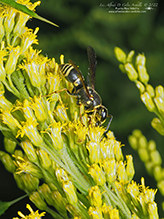 |
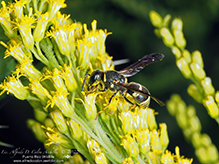 |
|
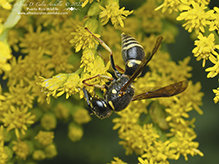 |
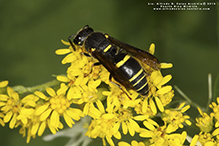 |
|
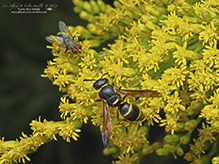 |
||
MinnesotaSeasons.com Photos |
||
|
||
|
||

Slideshows |
|

Visitor Videos |
||
Share your video of this insect. |
||
This button not working for you? |
||
|
Other Videos |
||
Euodynerus foraminatus MASON WASP uses mandibles to dig 3023136 |
About
Jun 27, 2023 Euodynerus foraminatus MASON WASP uses mandibles to dig burrow.. |

Visitor Sightings |
||
Report a sighting of this insect. |
||
This button not working for you? |
||
| Alfredo Colon 8/25/2022 |
Location: Albany, NY |
 |
Alfredo Colon |
Location: Albany, NY |
 |
| Alfredo Colon 8/15/2022 |
Location: Albany, NY |
 |
| Alfredo Colon 8/22/2019 |
Location: Woodbury, MN |
 |
MinnesotaSeasons.com Sightings |
||
|

Created: 5/14/2023 Last Updated: © MinnesotaSeasons.com. All rights reserved. |
